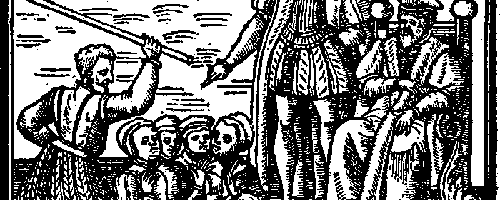The following is a chapter from Money, Sex, Power & Faith.
Order your copy in paperback or for Kindle!
“Thou shalt not suffer a witch to live.”
– Exodus 22:18, King James Version
As the eldest daughter of Henry VIII, Mary had adopted her father’s taste for blood. Yet she had a greater affinity for the Catholic faith than her father, and a disdain for the Protestantism embraced by his successor, her half-brother Edward, whose ungranted dying wish was to see his sister removed from the royal lineage. The throne was instead bequeathed to his fifteen-year-old cousin Jane, who ruled for nine days before being imprisoned in the Tower of London, and executed the next year by her successor, Bloody Mary.
Mary is considered to be the first queen regnant, meaning that she was the first queen to rule by lineage instead of marriage. She patched things up with the Pope, and although she had promised that she would not force her subjects to follow her religion, the Pope’s enactment of the Heresy Act set her on the course to execute 283 Protestants for following their own religion instead of hers. The Heresy Act was a collusion of various acts passed by former monarchs and since repealed by Henry VIII.
The Heresy Act cited the reigns of Richard II, Henry IV, and Henry V, concerning the suppression of heresy and the punishment of heretics. Many of the Protestants thought it best to avoid being burned at the stake or beheaded and went into exile. For those who were actually seeking “a closer walk with Thee” beyond the burgeoning complications of the Holy See, or the persecution inflicted by the Queen, the Protestants still held to the acceptance of the scriptures, but they wanted their own interpretation. As the Catholic Bible had been translated from the Latin, the Reformers wanted to go back to the original text, and over the course of two years in Geneva, they produced the first Bible translated into English from the original Hebrew and Greek.
But there was also a caveat. The Bible included commentary that further guided the Protestant faith, refuting many of the Catholic doctrines and setting a new course toward a more puritanical version of Christianity. The Geneva version of the Bible became so popular that Scotland passed a law requiring every family to have one.
Although Elizabeth managed to diplomatically restore the Church of England to honor both Catholic and Protestant, when her cousin James, King of Scotland took the reign upon her death, he just had to shake things up a little bit more. Not a big fan of the annotations and opinions of the Geneva Bible, one of his first orders of business was to establish a unified translation of the canonical books of the Bible to better accentuate the newly established Anglican faith. Basically, he wanted his own Bible.
Despite being a rather revered king, James had a rough start as a child. His father was murdered and his mother fled after marrying one of the primary suspects. With no siblings, parents, or grandparents, James was raised by guardians and suffered through a case of rickets in his youth that almost left him unable to walk.
It is suspected that James started experimenting with homosexuality when he was thirteen years old. Although he eventually married Anne of Denmark for political reasons and fathered eight of her children, he didn’t attend his own wedding, and was known to entertain male courtesans throughout his life. Due to the fact that male/male sexual relationships were condemned by his religion, it may have been James’ self-loathing that guided him on his witch hunts.
Witch hunts had grown increasingly popular in Denmark and Norway, and after harsh storms forced him to go retrieve his new bride as she was waylaid on her way to Scotland, the superstitious James convinced himself that evil was afoot and that witches were trying to keep he and his new bride apart. James oversaw the first witch trials in Scotland, convicting and executing over a hundred citizens suspected of witchcraft.
He went on to write Daemonologie, a booklet condemning the practice of witchcraft, and had it immediately republished when he ascended as the King of England in 1603, before he ordered the translation of his own Bible. The book is written as a dialogue between a skeptic named Philomathes and a guy named Epistemon, who goes to great lengths to describe all of the terrible things that witches do and why they should be put to death. In the second “argument” he presents as a rationale for witch hunts, he states that only the “elect” have a restored relationship with God after man’s fall from grace, and the rest get great pleasure out of irreverence for the God from Whom they’ve been separated.
Started in 1604, the King James Version of the Bible was touted as another direct translation from the Hebrew Old Testament, as well as the Greek New Testament and Apocrypha, by six committees of forty-seven scholars of various backgrounds over the next seven years. However, many believe it was actually largely translated directly from the Great Bible, which itself, had been translated from German. And although many were heading to the New World to get out from under the complexity and invasiveness of the Church, this newly printed edition of the “Good Book” still took hold as a guiding light for those making the journey. The Geneva Bible was largely the book of choice for those traveling to the New World, and it is thought that the first King James Version didn’t reach American soil until 1620. Without the roughly 300,000 words of annotation, the King James Version was a might bit slimmer than the Geneva Bible, and came to overtake it in popularity.
Considering James’ influence on the society in which we live, as the man who published the most widely read version of the all time best-selling book, and empowered the foundation of the America we know with Jamestown, it seems as if the internal conflicts that he faced have reverberated throughout the generations of people affected by his leadership. This is not an attack on his character, but a pragmatic look at the lonely little boy, whose mother’s perceived involvement in his father’s death left him without any family to speak of, which may have led to an unhealthy perspective on women, and some really serious daddy issues. While these issues may have guided him to have romantic feelings toward men and resentful relationships toward women, his childhood was spent battling disease and poring over scripture before assuming the Scottish throne at the tender age of seventeen.
As the first man to call himself “King of Great Britain, France, and Ireland” and to design the combination of the crosses of Saint George and Saint Andrew to develop the Union Jack, which still serves as the flag of the United Kingdom, James’ political legacy was pivotal to the development of the world we know. Yet the often unspoken legacy of persecuting and executing those who believed differently, ranging from witches to Protestants, his obsession with superstition, the internal conflict between carnal desires and religious dogma, and his investment in tobacco despite his hatred for it, seem to have also set a standard for many of the problems we face today.
Perhaps if we look honestly at the roots from which we have grown, we can forgive the sins of the past and move forward into a future of greater understanding. Throughout the back and forth game of religious adherence that seemed to change from noble to noble, and the severe punishments which came from not following the latest religious trends, many were seeing a trip to the New World as the only viable escape from the tyranny which accompanied it. Yet for those who were chased into that exile, the psychological damage was already done, and the spirit of judgment inflicted upon them would serve as a shadowy foundation in the New World they were developing.
Order your copy of Money, Sex, Power & Faith today!


